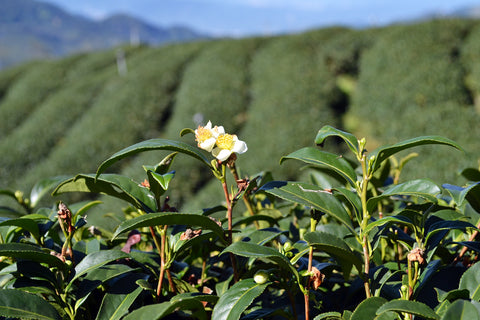
What is Tea?
To explain what tea is, we need to understand where it comes from. Simply put, tea is a beverage prepared by infusing processed tea leaves (Camellia sinensis) with water.
Tea vs Tisane
We use the word tea quite liberally referring to any infusions made of herbs and flowers (mint, ginger, and chamomile) as well as from the tea plant Camellia sinensis.
Technically speaking, the word “tea” only refers to an infusion made from the tea plant, Camellia sinensis, and it comes in categories of green, white, oolong, and black tea.
Infusions made with any other plants, would be categorized as Tisane or herbal infusions.
- Tea - infusions made with Camellia Sinensis
- Tisane - infusions made with herbs, fruits, roots, and flowers.
Where does the plant Camellia Sinensis come from?
Camellia Sinensis is a plant native to East Asia but is now grown all over the world. The tea plant is an evergreen shrub characterized by narrow and oval leaves and a white flower. The tea plant grows best in tropical and subtropical climates, around 2,000 miles north and south of the Tropic of Cancer.
Today, the most historically famous and high-quality teas come from four main regions: China, India, Taiwan, Japan.

How was tea discovered?
Tea originated in China. The most famous legend says that the Chinese Emperor Shen Nung, 2,737 a.c., was boiling water when leaves of a nearby tree fell into the pot. The Emperor found that it improved the taste of the water and also had an invigorating effect on the body. Since then, tea has been used as an ingredient, a medicine, and ultimately a single ingredient beverage.
Tea was discovered in China and has been consumed as a beverage for over 4,000 years. It is the world’s second most-consumed beverage next to water. Tea drinking and production spread to Japan through Buddhist monks started around 700 AD (Tang Dynasty in China) and the first sets of seeds were planted in 1191, but it wasn’t until around 1860 that the production of tea spread outside Asia through the East India Trading Company.
Source: https://www.itoen-global.com/allabout_greentea/history_of_tea.html
Where is tea made today?
In 2018, the world produced 6.4 tonnes of tea across 48 countries. China was the largest producer at around 41% of the world’s tea production. India was second at 21%. Kenya took third at 8% and Sri Lanka fourth at 5%. Japan and Taiwan were darling tea regions that produce high-quality teas in small quantities at 1.3% and 0.2% respectively.
How is tea made?
Tea is made by processing the harvested Camellia Sinensis leaves then drying it for preservation and transport. The processing methods have been refined over thousands of years. Each style of tea is processed differently and is influenced by its heritage.
Different processing methods, mainly the level of oxidation, define the types of tea (green, oolong, black, white etc.).
Below is a chart that articulates each of the processing steps by tea style.
Please note this chart summarizes generic processing steps and may not apply to every producing region. Each culture and small localities often have their own variations which makes them unique.
- White tea: Fresh tea leaves → withered → dried → sorted → firing (optional) → packaged
- Green tea: Fresh tea leaves → withered (optional) → high heat (halting oxidation) → rolling/shaping → dried → sorted → packaged
- Yellow tea: Fresh tea leaves → withered (optional) → medium heat (slowing oxidation) → sweltering → rolling/shaping → dried → sorted → packaged
- Oolong tea: Fresh tea leaves → sun withered → indoor withered ↔ agitation/bruising → high heat (halting oxidation) → rolling/shaping → dried → sorted → roasted (optional) → packaged
- Black tea (Red tea): Fresh tea leaves → withered (indoor or outdoor) ↔ rolling/shaping → sweltering/oxidation → dried → sorted → firing (optional) → packaged
- Black/Dark tea (post-fermented), often in disc or brick form: Fresh tea leaves → high heat (halt oxidation) → agitation → sweltering/fermenting (for shou pu-erh) → shaping (into disk or bricks) → drying → packaging → aging (optional)
What other factors influence the taste and aroma of teas?
- Tea plant variety: There are two major tea varieties: Camellia sinensis var. Assamica & Camellia sinensis var. Sinensis and there are thousands of tea cultivars that belong to each variety. Think fuji apples in the category of red apples to the family of apples.
- Growing condition: Tea plants grown in different weather conditions and soil structure will yield different types of harvest. Different season’s harvest will also impact the flavor and aroma.
- Cultural heritage: Different cultures appreciate different attributes in tea. For example, grassiness is welcomed in Japanese tea production but less so in Taiwanese tea production. Therefore we see Taiwanese green tea makers oxidizing the teas lightly to reduce grass notes. Chinese teas are valued by the small lot, which can vary season by season, whereas Japanese tea makers value consistency therefore they blend a few different lots of tea to get a consistent flavor year on year.

Picture of Camellia sinensis var. Sinensis (left) & Camellia sinensis var. Assamica (right)
In Summary
Similar to wine, different styles of tea are distinguished by plant variety, growing condition, and processing methods. Each tea variety has its own flavor, color, and aroma.
